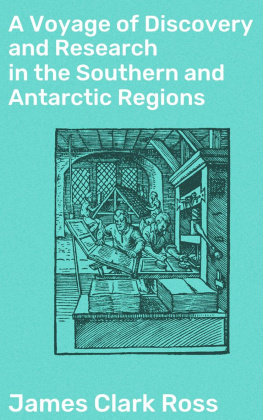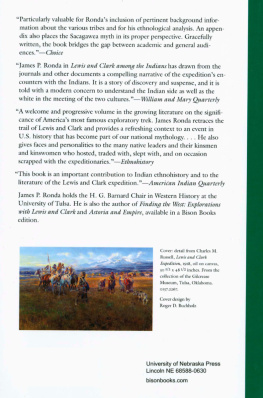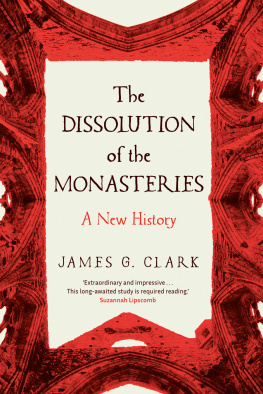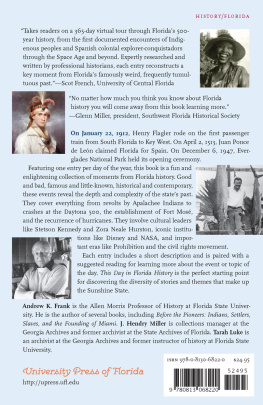Published by The History Press
Charleston, SC 29403
www.historypress.net
Copyright 2014 by James C. Clark
All rights reserved
Cover photos courtesy of Florida Archives Photographic Collection.
First published 2014
e-book edition 2014
ISBN 978.1.62585.153.6
Library of Congress Cataloging-in-Publication Data
Clark, James C., 1947-
A concise history of Florida / James C. Clark.
pages cm.
Includes bibliographical references and index.
print edition ISBN 978-1-62619-618-6
1. Florida--History. I. Title.
F311.C52 2014
975.9--dc23
2014035064
Notice: The information in this book is true and complete to the best of our knowledge. It is offered without guarantee on the part of the author or The History Press. The author and The History Press disclaim all liability in connection with the use of this book.
All rights reserved. No part of this book may be reproduced or transmitted in any form whatsoever without prior written permission from the publisher except in the case of brief quotations embodied in critical articles and reviews.
ACKNOWLEDGEMENTS
This book carries the name of a single author, but it is really the work of dozens of people whose research and encouragement proved invaluable in writing it. At the University of Florida, I was fortunate to study with legendary Florida historians David Colburn, Samuel Proctor, George Pozzetta and Michael Gannon. They produced two generations of Florida historians. Many of those I was fortunate enough to study with have become leaders in the study of Florida history, and their work contributed to this book. Jane Landers at Vanderbilt, Sherry Jackson at Florida International University, Andrew Frank of Florida State University, Susan Parker of the St. Augustine Historical Society, David Tegeder at Santa Fe College and Steven Noll at the University of Florida all produced work that made my journey much easier. The University of Central Florida has become a major center for the study of Florida history, and I am grateful for the work of Connie Lester, Dan Murphree and Robert Cassanello, who have done much to advance the study of the states history. Dr. Jerrell Shofner, the former chair of the UCF History Department has been a source of inspiration for nearly three decades, and his work in Florida history has always helped me.
Jon Findell of the University of Central Floridas Faculty Media Center continues his role of friend and great source of help. Ray Arsenault and Gary Mormino of the University of South Florida, Paul George of Miami-Dade College, Jack Davis of the University of Florida, Mike Denham of Florida Southern College and Tracy Revels of Wofford College did significant work to aid this book. The work of journalists Joy Dickinson of the Orlando Sentinel and Craig Pittman of the Tampa Bay Times have helped in my research.
Adam Watson of the Florida State Archives has again come through with the help I needed, as has Cynthia Cardona Melendez of the Orange County Regional History Center. At The History Press, Alyssa Pierce and Julia Turner have shown great patience in working with me, and I am thankful. I am especially grateful to Laureen Crowley whose editing made this book what it is.
SETTLING FLORIDA
More than ten thousand years ago, as the great glaciers began to melt, Florida began to take shape. It had the same general shape as it has today, only it was twice as wide. St. Petersburg would have been one hundred miles inland during this period. As the glaciers melted, the sea level rose, and the peninsula of Florida was reduced to its present size. (The Florida peninsula is so distinctive that astronaut Neil Armstrong said Florida was the first shape on earth he recognized as he returned from his walk on the moon.)
Four thousand miles away, ice created a bridge from Siberia to Alaska, allowing people to enter North America. They scattered across the continent and reached Florida nearly sixteen thousand years ago.
The first Floridians hunted animals far different from those found today. They hunted bison, camels, mastodons and mammoths, but when hunting wiped those creatures out, the people turned to more traditional game such as rabbits and deer. Floridas first settlements formed around springs, such as Warm Mineral Springs in present-day Sarasota.
The people who settled along the coastline moved farther inland as the sea level rose. By 5,000 BC, the Florida climate had become what it is today.
The population increased, and the native tribes built villages. Archaeologists have found that around 2,000 BC, the tribes made fired-clay pottery.
By 500 BC, there were established tribes throughout the peninsula, including the Timucuan, Calusa and Apalachee, with smaller tribes in more far-flung locations. The Ais lived near the Indian River, Creeks and Choctaws in the panhandle, the Matacumbes in the Florida Keys and the Tequestas in southeast Florida.
Hernando de Soto led an expedition through Florida and what is now the southeastern United States. Florida Archives Photographic Collection.
Credited with the European discovery of Florida, Ponce de Len named it after the Feast of Flowers. Florida Archives Photographic Collection.
The Timucuans established a number of villages in north-central Florida. They grew corn and gathered fruits and berries. The Timucuan villages featured a cluster of small huts surrounded by a circular twelve-foot-high wall of tree trunks. They had a rigid feudal system with a chief and council.
The Calusa Indians in the southern half of the peninsula lived in nearly fifty villages.
The population estimates vary widely; however, by the time the Europeans arrived, there were between 100,000 and 300,000 people in Florida.
There was one tribe that would become synonymous with Florida that was not presentthe Seminoles. They were late arrivals, not moving into Florida until the 1700s.
Although Juan Ponce de Len gets the credit for the discovery of Florida, there are indications that the peoples of the Caribbean islands, such as Cuba, moved between the islands and Florida much earlier. The people who came might have been looking for slaves and avoided publicizing their voyages. Crude forms of Florida first appear on maps around 1500. One sign that the Spanish had come before is seen in the hostile reaction Ponce de Len and other explorers received. The Indians had apparently encountered the outsiders before, and the experience was negative.
TIMELINE 14,000 BCAD 700
14,000 BC: The first people arrive in Florida.
9,000 BC: Glaciers melt, and Florida shrinks. The peninsula was once twice as wide.
7,500 BC: People hunted, gathered and started settlements during the Archaic period.
5,000 BC: First semipermanent settlements in Florida.
4,000 BC: Settlements are established along the St. Johns River and near present-day Tampa.












